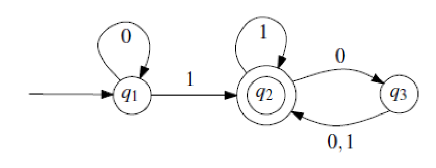What language does each of the following regular expressions represent?
- \(ab\)
- \((a \cup b \cup \epsilon)\)
- \((ab \cup a)b\)
- \(a(a \cup b) \cup b(b \cup a)\)
- \(ab^*\)
- \((aa)^*\)
- \((ab)^* \cup b^*\)
- \((a^*b^*)^*\)
Write a regular expression that describes each of the following languages over \(\Sigma = \{0, 1\}\):
- \(\{w : w \text{ contains at least three $1$'s}\}\)
- \(\{w : |w| \text{ is odd}\}\)
- \(\{w : \text{ every odd position in $w$ is $1$}\}\)
Give a regular expression that describes the language accepted by the following DFA:
